Primary fermentation temperature control issues can stem from several factors. Ambient temperature changes can affect fermentation conditions, while yeast strain selection is vital since different strains prefer specific temperature ranges. Inadequate insulation can also lead to overheating or inadequate warmth. Additionally, active fermentation can raise internal temperatures by up to 10°F. Monitoring is fundamental to guarantee you’re maintaining ideal conditions. Helpful hints include using insulation and regularly checking temperatures, which can prevent unwanted flavor issues. You’ll find more insights below.
At a Glance
- Ambient temperature fluctuations can significantly affect fermentation, causing temperature control issues during primary fermentation.
- Larger fermentation vessels may overheat due to increased yeast activity, leading to higher internal temperatures.
- Inadequate insulation can result in excessive heat buildup, impacting yeast performance and fermentation quality.
- Inconsistent thermometer readings and improper monitoring can mislead brewers about the actual fermentation temperature.
- Active fermentation can raise internal temperatures by up to 10°F, necessitating regular temperature checks for effective management.
Understanding Fermentation Temperature Sensitivity
When you’re brewing beer, it’s important to grasp how sensitive yeast is to temperature changes. Yeast strains thrive within specific fermentation temperatures, typically between 70° and 75°F. High temperatures above 80°F can lead to off-flavors, such as harsh esters and fusel alcohols.
On the other hand, low temperatures might cause yeast dormancy, stalling fermentation. The first 72 hours of primary fermentation are critical, as this is when yeast is most active. Proper temperature control is essential, preventing diacetyl production, which contributes unwanted buttery flavors to your brew. Maintaining a consistent temperature control is crucial to avoid stress on the yeast, which can lead to undesirable fermentation outcomes.
Helpful Hints:
- Monitor fermentation temperatures closely.
- Adjust temperature gradually.
Common Causes of Temperature Fluctuations
Temperature fluctuations during fermentation can be a significant challenge for homebrewers. Several factors contribute to this issue.
Temperature variations can pose serious challenges for homebrewers, influenced by numerous environmental factors during fermentation.
First, ambient temperature changes, like seasonal shifts, can alter your fermentation temperature.
Second, larger fermentation vessels may overheat due to increased yeast strain activity.
Third, inadequate insulation or lack of a temperature controller can lead to excessive heat buildup.
Finally, improper monitoring and inconsistent use of thermometers can result in inaccurate readings, complicating your brewing process.
To minimize these fluctuations, guarantee proper insulation, utilize cooling methods, and regularly check temperatures for a successful fermentation outcome. Additionally, monitoring fermentation is essential to ensure fermentation is progressing properly and to prevent off-flavors.
Helpful Hints:
- Use a reliable temperature controller.
- Insulate fermentation vessels.
- Monitor temperatures consistently.
The Impact of Ambient Temperature on Fermentation
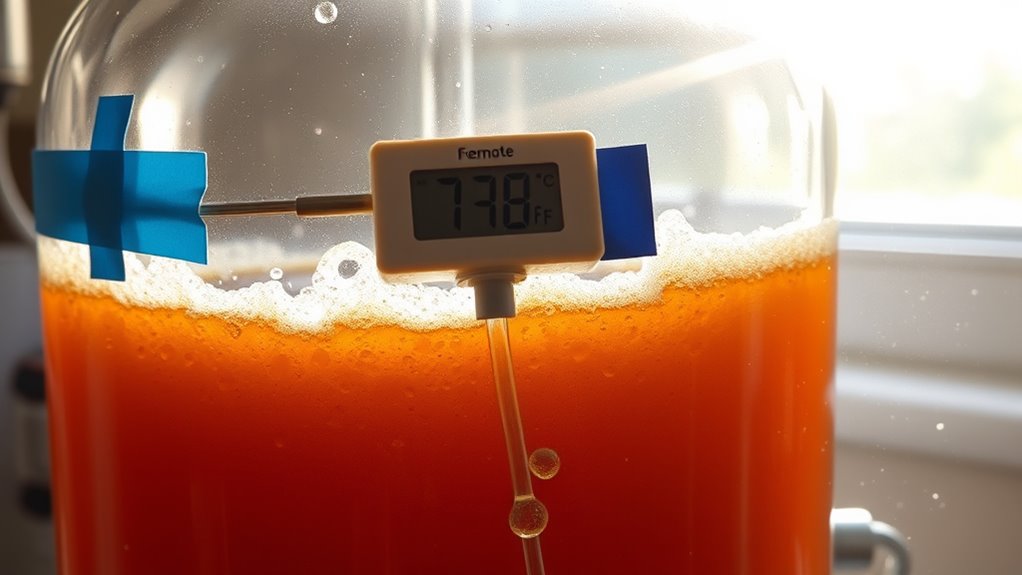
Understanding how ambient temperature affects fermentation is crucial for homebrewers aiming for high-quality results. Ambient temperature can greatly impact fermentation temperature, influencing yeast activity.
If it exceeds 80°F, you risk off-flavors and spoilage due to stressed yeast. Remember that active fermentation can raise internal temperatures by up to 10°F, making temperature control essential for success. To mitigate these effects, consider using smaller fermenters for better heat dissipation. Additionally, placing your fermenter in a cool corner or using water immersion techniques can help maintain a stable fermentation environment, counteracting fluctuations caused by ambient temperature changes. Proper sanitization of equipment is also vital to prevent contamination during fermentation.
Helpful Hints:
- Monitor ambient temperature regularly.
- Choose appropriate fermentation locations.
- Implement cooling methods as needed.
Yeast Strain Selection and Temperature Preferences
Selecting the right yeast strain for fermentation is a key factor that influences the final characteristics of your brew. Different yeast strains have specific temperature preferences; for instance, ale yeast thrives between 65-75°F, while lager yeast prefers 45-55°F.
Kveik strains can ferment at temperatures up to 90°F without producing off-flavors, making them ideal for warmer conditions. Higher fermentation temperatures often enhance esters and phenols, resulting in fruity or spicy notes. Additionally, yeast strain selection can significantly impact hop expression and overall flavor profile in IPAs.
Choosing a yeast strain that aligns with your intended fermentation temperature is essential for achieving desired flavors and avoiding fermentation issues, such as off-flavors or stuck fermentation.
Helpful Hints:
- Always check the yeast strain’s temperature range.
- Experiment with Kveik for innovative brews.
- Monitor temperatures closely during fermentation.
Insulation and Equipment Considerations
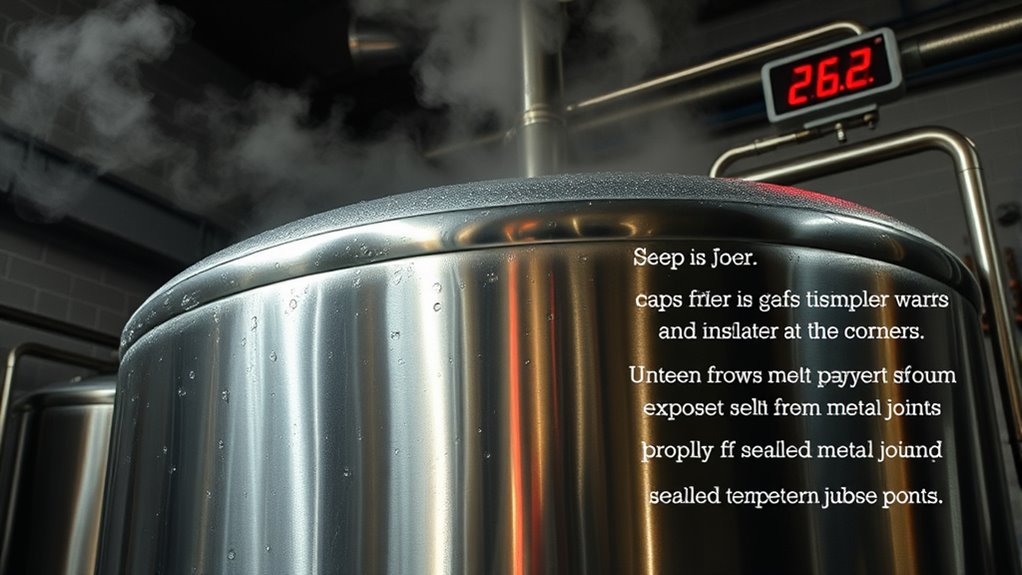
When you’re brewing beer, maintaining a consistent fermentation temperature is fundamental, as fluctuations can lead to undesirable flavors or fermentation issues.
Proper insulation of your fermenters is important; it minimizes heat loss or gain from the environment. Investing in temperature-controlled fermentation equipment, like dedicated refrigerators, guarantees precise regulation, crucial for quality. Additionally, ensuring your equipment is properly sanitized helps prevent contamination that could affect fermentation outcomes.
Smaller fermenters enhance temperature control due to better heat dissipation. Consider using the evaporation method with wet fabric and fans for cooling, but monitor closely to prevent overcooling.
Finally, if using ice blocks, check frequently to keep temperatures ideal for your chosen yeast strain.
Helpful Hints:
- Insulate fermenters to stabilize temperature.
- Use temperature-controlled equipment for precision.
- Opt for smaller fermenters for better control.
- Monitor evaporation methods carefully.
- Regularly check cooling methods for ideal yeast performance.
Monitoring Techniques for Fermentation Temperature
How do you guarantee your fermentation temperature stays consistent throughout the brewing process?
To enhance temperature control, consider using temperature probes, which provide accurate readings of the wort. Stick-on thermometers can mislead you about actual fermentation conditions.
Immersing fermenters in water stabilizes temperature fluctuations, thanks to water’s high thermal mass. Regularly monitoring fermentation temperatures is crucial, as active fermentation can raise internal temperatures considerably, impacting yeast performance and flavor. Maintaining the right mash pH is also important, as it can affect the overall flavor profile of the beer.
Experimenting with various temperature monitoring methods can lead to improved outcomes, as understanding your fermentation environment is key to managing temperature effectively.
Helpful Hints:
- Use probes for precision.
- Experiment with water immersion.
Effects of Overheating During Fermentation
Overheating during fermentation can have significant consequences for your brew, particularly if temperatures exceed 80°F. Excessive heat can damage yeast cells, disrupting yeast activity, and leading to ineffective fermentation.
Overheating during fermentation can severely impact your brew, especially when temperatures rise above 80°F, harming yeast activity.
This results in off-flavors, such as fusel alcohols, and an overwhelming presence of esters and phenols, which can mask your intended flavor profile. Additionally, high fermentation temperatures may cause a rapid internal temperature rise, potentially resulting in a stuck fermentation. To prevent undesirable compounds like diacetyl, effective temperature control is essential. Furthermore, adequate wort aeration is crucial to support yeast metabolism and reduce the risk of slow fermentation.
Helpful Hints:
- Monitor fermentation temperatures closely.
- Avoid temperature spikes above the nominal range.
Solutions for Managing Low Temperatures
Maintaining proper fermentation temperatures is essential for achieving a successful brew, especially when faced with cooler conditions.
To manage low temperatures effectively, consider these solutions:
- Use an Immersion Heater: This keeps the fermenter warm, ensuring yeast remains active.
- Insulate the Fermenter: Blankets or foam retain heat generated during fermentation.
- Choose a Warm Location: Place your fermenter near a radiator or in a closet for a stable environment.
- Employ a Fermentation Chamber: This offers precise temperature control.
- Add Yeast Nutrients: Boosting yeast activity can combat sluggish fermentation at low temperatures. Additionally, ensuring proper sanitation control during the brewing process is critical for preventing contamination that can further affect fermentation.
Importance of Consistent Temperature Control
When you’re brewing beer, keeping the fermentation temperature consistent can mean the difference between a successful batch and one that falls flat.
Maintaining ideal fermentation temperatures allows yeast to thrive, especially during the vital first 72 hours. High temperatures can lead to off-flavors and spoilage, while low temperatures can cause yeast dormancy.
A consistent fermentation temperature also prevents diacetyl production, which results in undesirable buttery flavors. Using smaller fermenters can enhance your ability to control temperature, as they dissipate heat more effectively. Additionally, consistent temperatures during fermentation ensure the desired balance of fermentable and unfermentable sugars, which directly influences the body and sweetness of your beer.
Remember, active fermentation can raise internal temperatures by 10°F, so careful monitoring is essential for great results.
Helpful Hints:
- Invest in a temperature controller.
- Regularly check fermentation progress.
- Choose the right fermenter size.
Troubleshooting Off-Flavors Related to Temperature Issues
Understanding how temperature affects fermentation is essential for producing a quality beer. High fermentation temperatures above 80°F can lead to off-flavors such as fusel alcohols and harsh esters.
Temperature plays a crucial role in fermentation, with high levels producing undesirable off-flavors in beer.
Conversely, low temperatures may cause yeast dormancy, resulting in incomplete fermentation and residual sugars that create off-flavors. Sudden temperature spikes can shock yeast, impairing their activity and resulting in inconsistent flavors.
Additionally, cooling fermentation too early can prevent yeast from metabolizing diacetyl, a buttery off-flavor.
Helpful Hints
- Monitor fermentation temperatures consistently.
- Gradually adjust temperatures to prevent shock.
- Allow yeast to complete fermentation fully.
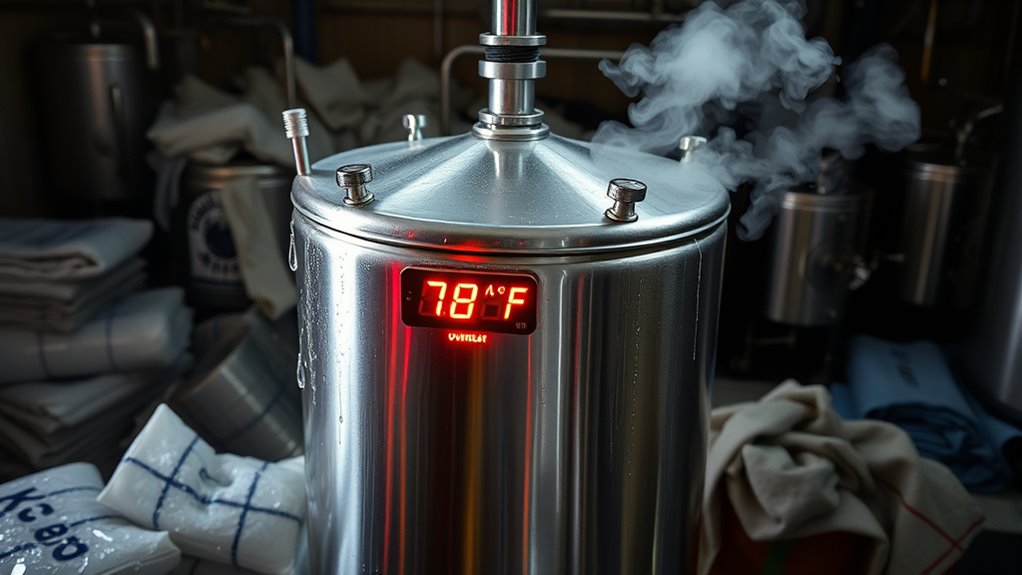
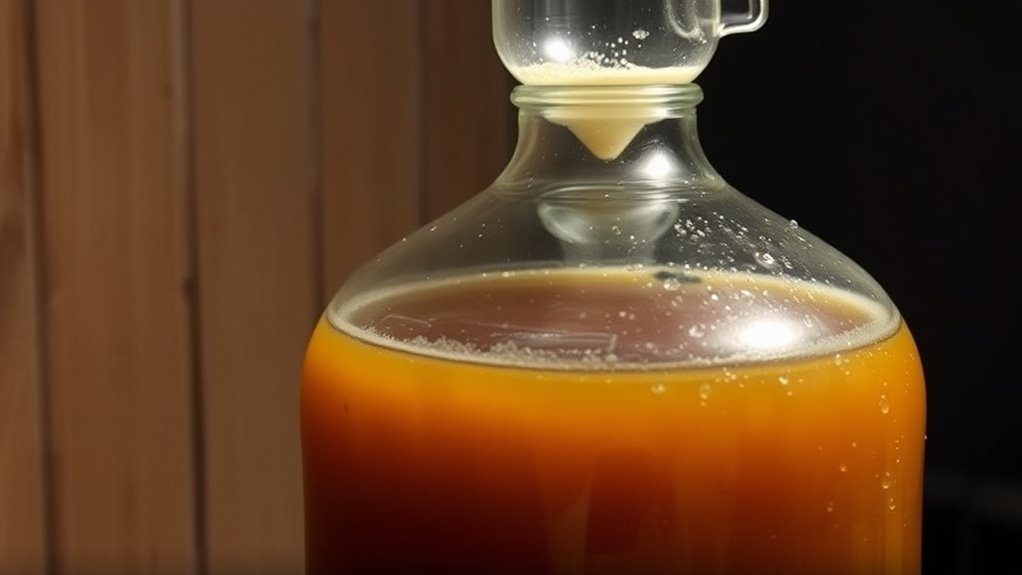
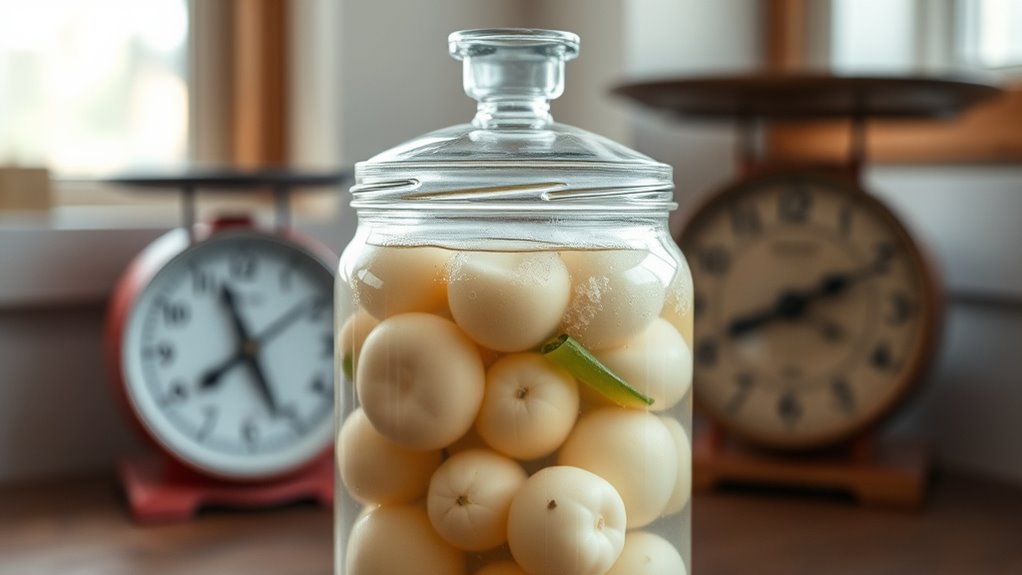
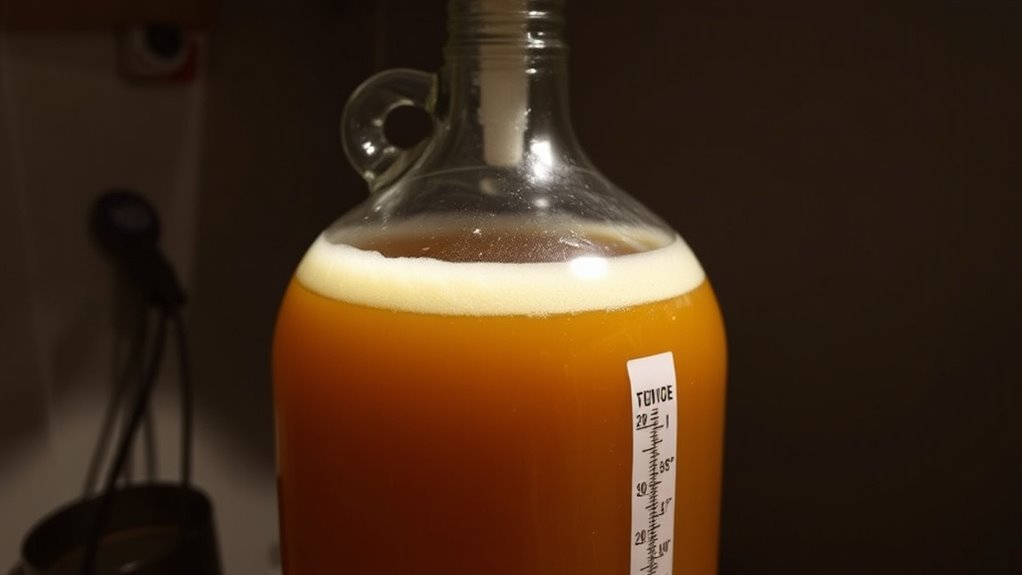
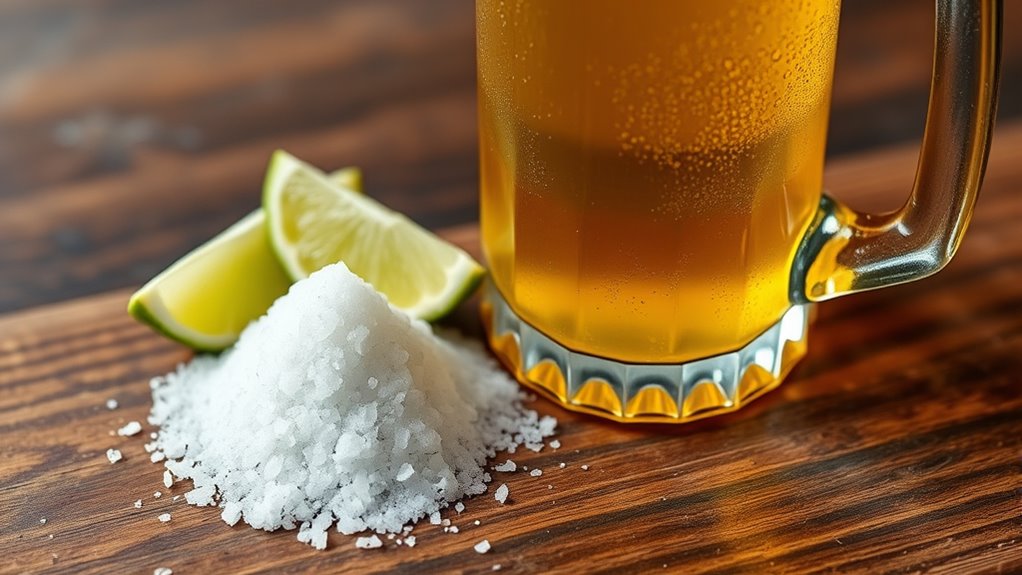
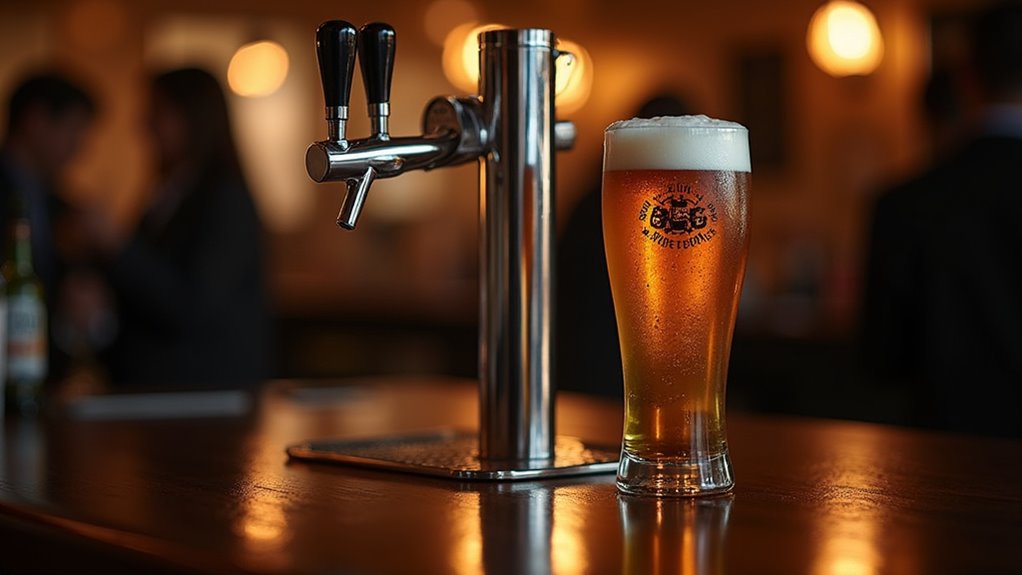
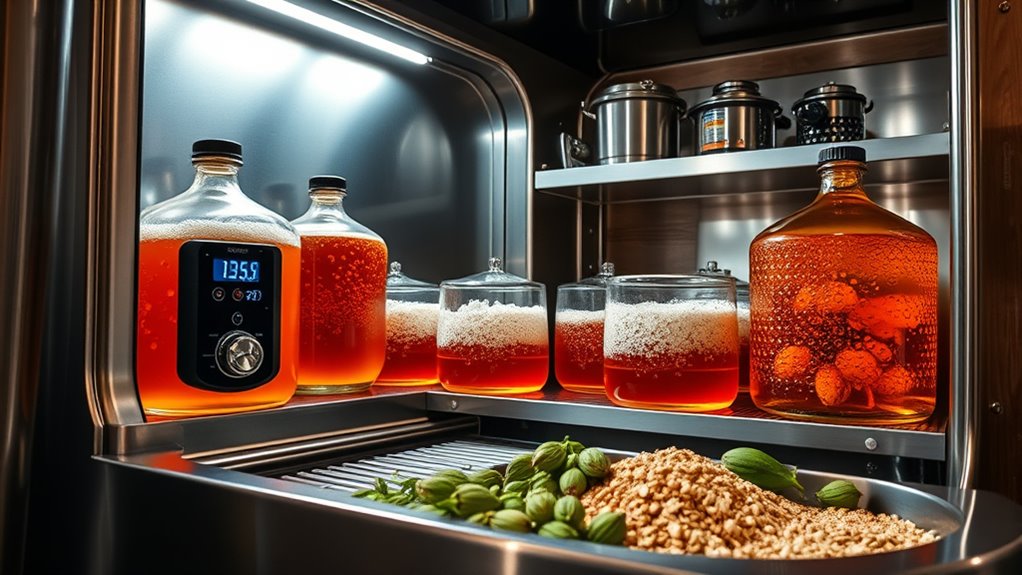
2 comments
Comments are closed.